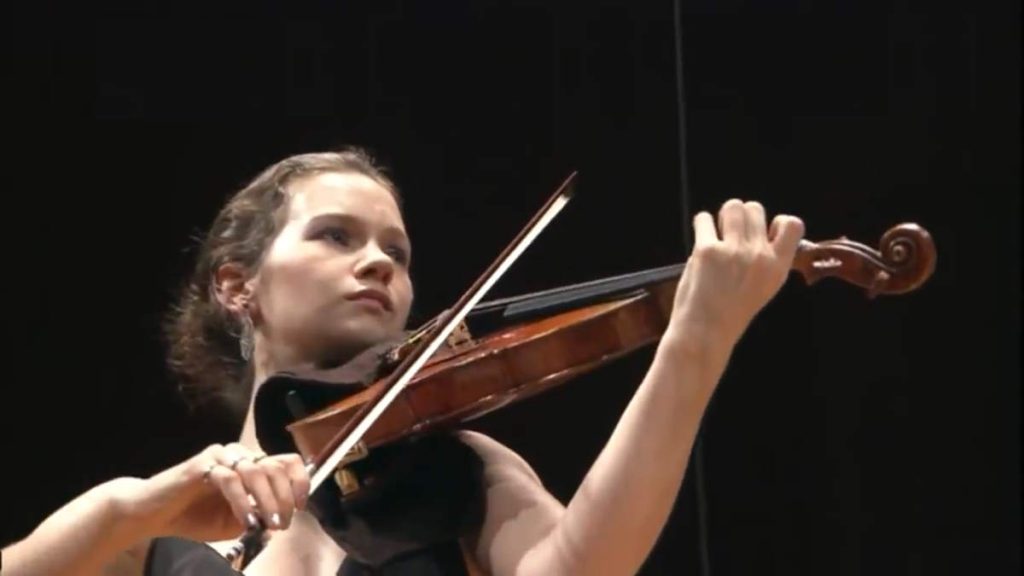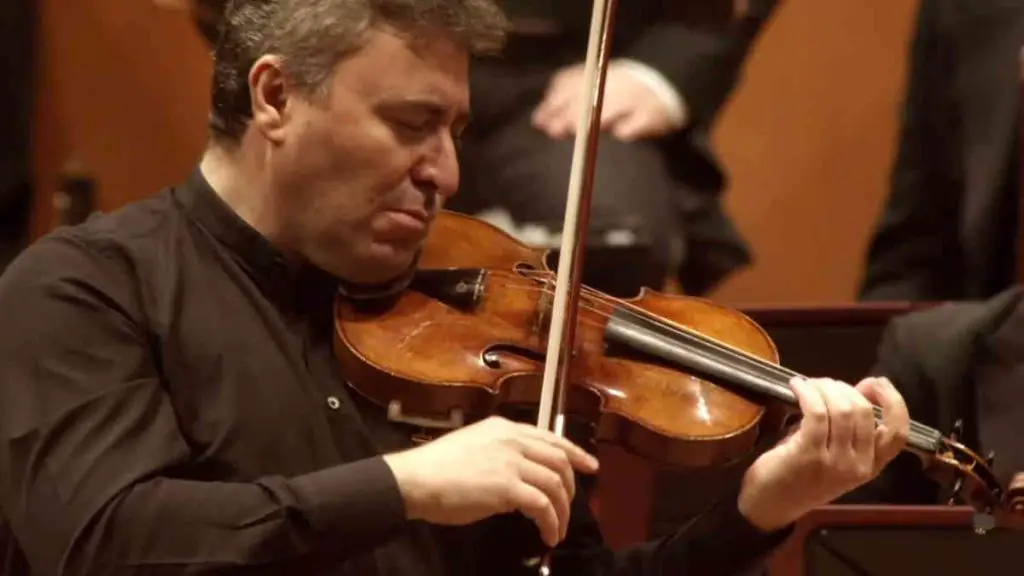Accompanied by the Dresden Philharmonic, the German classical violinist and pianist Julia Fischer performs Felix Mendelssohn’s Violin Concerto in E minor, Op. 64. Conductor: Michael Sanderling. This performance was recorded at the Kulturpalast Dresden in April 2017.
Felix Mendelssohn’s Violin Concerto
Felix Mendelssohn’s Violin Concerto in E minor, Op. 64 is one of the most celebrated works in the violin repertoire and a cornerstone of the Romantic era. Completed in 1844, it was the last large orchestral piece Mendelssohn finished before his untimely death in 1847. Dedicated to his friend, the virtuoso violinist Ferdinand David, the concerto is remarkable not only for its beauty but also for its innovations in form, orchestration, and violin technique.
One of its most striking qualities is how seamlessly it integrates the solo violin with the orchestra. Rather than treating the soloist as a competitor or mere ornament to the ensemble, Mendelssohn created a partnership where both forces complement one another. The result is a concerto that feels less like a contest of strength and more like an eloquent dialogue, filled with lyricism, drama, and elegance. This balance between virtuosity and musical substance helped set a new standard for concertos that followed.
Another innovation was Mendelssohn’s decision to begin with the solo violin almost immediately, skipping the traditional orchestral introduction. This created a sense of urgency and intimacy that was unusual for its time. He also linked the sections of the concerto without breaks, ensuring a continuous flow of music rather than isolated movements. These structural choices gave the piece a sense of cohesion and organic development that was admired by later composers such as Tchaikovsky and Sibelius, who modeled aspects of their own violin concertos on it.
The concerto is also notable for its technical demands. It showcases the violin’s brilliance-rapid passagework, soaring lines, and expressive cantabile melodies. It never becomes an empty display. Instead, the virtuosity always serves musical expression, reflecting Mendelssohn’s refinement and restraint as a composer. Its lyrical themes, elegant textures, and dramatic contrasts make it both deeply expressive and dazzling, a combination that continues to captivate audiences.
Today, the Mendelssohn Violin Concerto remains one of the most frequently performed violin concertos in the world. It is prized equally by performers and listeners for its perfect balance of emotional depth, technical brilliance, and formal innovation. More than 175 years after its premiere, it still embodies the Romantic spirit with freshness and vitality, ensuring its place as a timeless masterpiece.
Movements
With start times in the video:
- (00:00) Allegro molto appassionato
- (12:57) Andante
- (20:58) Allegretto non troppo – Allegro molto vivace
1. Allegro molto appassionato
The Allegro molto appassionato opening of Mendelssohn’s Violin Concerto in E minor, Op. 64 immediately sets the emotional tone of the work. Unlike earlier Classical concertos that began with an orchestral introduction, Mendelssohn launches almost at once into the violin’s voice, with a passionate, sweeping theme in E minor. This was a striking innovation in 1844, giving the impression of urgency and emotional directness. The soloist enters as the protagonist, driving the narrative forward rather than waiting for the orchestra to establish the scene.
The principal theme is lyrical but tinged with restlessness, embodying the “appassionato” character Mendelssohn envisioned. The orchestra supports the violin with delicate textures, never overshadowing it, allowing the soloist’s intensity to shine through. Mendelssohn maintains an elegant balance between dramatic outbursts and moments of tender lyricism, creating a dialogue where passion and grace coexist.
Virtuosity is an integral part of this movement, but it is never an empty display. Rapid arpeggios, scales, and double stops challenge the performer, yet each technical passage grows organically out of the music’s emotional demands. The violin’s lines often soar high above the orchestra, giving the impression of a voice filled with longing and determination.
One of Mendelssohn’s greatest innovations in this movement is his treatment of the cadenza. Instead of leaving it as a showpiece near the very end, he composed it himself and placed it before the recapitulation. This means the cadenza is not an interruption but a structural bridge – it deepens the drama, intensifies the passion, and then leads seamlessly back to the opening theme. By integrating the cadenza into the narrative, Mendelssohn transformed what had been a performer’s indulgence into a vital part of the movement’s architecture.
The movement closes with a fiery drive, maintaining its impassioned energy until the end. Its blend of lyricism, innovation, and virtuosic brilliance established a new model for Romantic concertos and ensured its place as one of the most admired openings in the violin repertoire.
2. Andante
The second movement of Mendelssohn’s Violin Concerto in E minor, Op. 64, marked Andante and set in C major, provides a serene and lyrical contrast to the passionate intensity of the opening. Flowing gently after the fiery Allegro molto appassionato, it offers a moment of calm reflection, almost like an aria for the violin. Many have described it as songlike in character, highlighting Mendelssohn’s gift for melody and his affinity for vocal writing.
The movement begins with a tender orchestral introduction, presenting a theme of quiet nobility. When the violin enters, it takes up the melody with warmth and expressive sensitivity. The solo line unfolds gracefully, resembling the voice of a singer delivering an intimate and heartfelt song.
The simplicity of the theme, combined with Mendelssohn’s refined orchestration, creates an atmosphere of pure lyricism. The orchestra provides a soft, steady foundation, often using muted strings and delicate wind writing, which allows the violin’s voice to glow above.
Despite its apparent calmness, the movement contains subtle emotional shifts. The violin sometimes introduces more passionate phrases, hinting at deeper undercurrents of longing or sorrow, before returning to tranquility. This balance of serenity and emotional depth reflects Mendelssohn’s Romantic sensibility-his ability to suggest profound feeling without ever becoming heavy-handed.
Technically, the movement is less demanding than the outer sections of the concerto, but it requires great control of tone, phrasing, and nuance. The violinist must sustain long, singing lines with clarity and warmth, projecting expressiveness through subtle dynamics and color rather than sheer brilliance.
The Andante serves as the emotional heart of the concerto, a moment of introspection and poetic beauty. It bridges the fiery passion of the first movement and the joyful energy of the finale, ensuring the work flows as a unified whole rather than as three disconnected parts. This seamless transition of moods is one of the concerto’s greatest achievements, and the Andante in particular is cherished for its purity and grace.
3. Allegretto non troppo – Allegro molto vivace
The finale of Mendelssohn’s Violin Concerto in E minor, Op. 64 is marked Allegretto non troppo – Allegro molto vivace, and it bursts forth with brightness and joy after the calm introspection of the Andante. Shifting from the shadowy minor world of the opening movement and the lyrical warmth of the slow movement, this closing section radiates vitality and playfulness, giving the concerto an uplifting conclusion.
The transition into the finale is particularly striking. Mendelssohn links the movements without pause, a structural innovation that maintains continuity across the entire concerto. The orchestra first introduces a light, almost mischievous idea, before the violin joins in with sparkling passagework that sets the energetic tone. The shift to E major brings a sense of release and triumph, as if the tension of the earlier movements finally resolves into radiant affirmation.
The solo violin dominates the finale with exuberant virtuosity. Rapid scales, arpeggios, and intricate bowing patterns drive the music forward with irresistible momentum. Yet, as always with Mendelssohn, the technical brilliance never overshadows the music’s spirit. The violin’s acrobatics sparkle like quicksilver, but the emphasis remains on charm and joy rather than sheer display. The orchestra participates fully in this brightness, with crisp rhythms and buoyant textures that match the violin’s effervescence.
Lyrical secondary themes occasionally soften the exuberance, offering moments of grace before the energy surges back. This interplay of elegance and vivacity keeps the finale fresh and varied. The music grows increasingly jubilant as it progresses, culminating in a dazzling conclusion that sweeps both soloist and orchestra into a triumphant finish.
The finale’s joyous character reflects Mendelssohn’s mastery of balance: it provides a dazzling showcase for the violinist, satisfies the concerto’s structural unity, and leaves the listener with a sense of exhilaration. Together with the passionate first movement and the lyrical Andante, this finale completes one of the most perfectly crafted and beloved concertos in the violin repertoire.
Sources
- Violin Concerto (Mendelssohn) on Wikipedia
- Violin Concerto in E Minor, Op. 64, work by Mendelssohn, on the Encyclopedia Britannica website
- “Mendelssohn’s Violin Concerto in E Minor, Op. 64: A Romantic Era Masterpiece” on the World of Musicality website
- Violin Concerto, Felix MENDELSSOHN on the L.A. Phil website
- “Mendelssohn: Violin Concerto” on the College Sidekick website
![Mendelssohn: Violin Concerto [Julia Fischer]](https://andantemoderato.com/wp-content/uploads/2023/04/Julia-Fischer-Mendelssohn-Violin-Concerto-1024x572.jpg)

